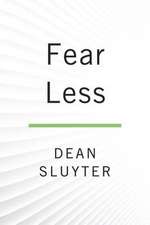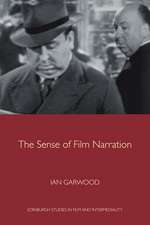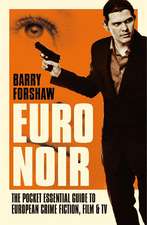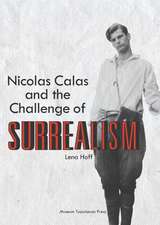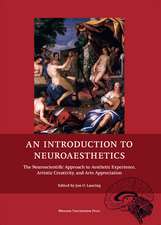Cinema Nirvana: Enlightenment Lessons from the Movies
Autor Dean Sluyter, Ean Sluyteren Limba Engleză Paperback – 31 ian 2005
So grab your popcorn, sit back, and prepare to have your mind opened. Cinema Nirvana is a funny but wise, practical but wildly entertaining guide to finding enlightenment—one movie at a time.
Preț: 112.23 lei
Nou
Puncte Express: 168
Preț estimativ în valută:
21.48€ • 22.48$ • 17.87£
21.48€ • 22.48$ • 17.87£
Carte disponibilă
Livrare economică 10-24 martie
Preluare comenzi: 021 569.72.76
Specificații
ISBN-13: 9781400049745
ISBN-10: 1400049741
Pagini: 304
Dimensiuni: 131 x 203 x 22 mm
Greutate: 0.35 kg
Ediția:New.
Editura: Three Rivers Press (CA)
ISBN-10: 1400049741
Pagini: 304
Dimensiuni: 131 x 203 x 22 mm
Greutate: 0.35 kg
Ediția:New.
Editura: Three Rivers Press (CA)
Extras
Snow White and the Seven Dwarfs (1937)
Dare to Be Dopey
So, in planning a new picture, we don’t think of grown-ups and we don’t think of children, but just of that fine, clean, unspoiled spot down deep in every one of us, that the world has maybe made us forget and maybe our pictures can help recall. —Walt Disney
As a role model, Snow White sucks. She’s an utterly passive fairy-tale heroine who climbs no beanstalks and slays no dragons. She has no talents but housecleaning and no interests beyond pining away for that Special Someone who will someday come and solve all her problems. Her shrill, girly voice attests to her empty-headed helplessness—she’s sisters-under-the-skin with the old politically incorrect Teen Talk Barbie that sighed, “Math is hard!” All she is is young and pretty, and not smart enough to understand that one day, like the Queen, she’ll be forty and washed up.
This sort of critique is valid as long as we’re viewing the film on a strictly literal level. But on that level, Jack and the Beanstalk teaches us to solve our problems by stealing and killing, and Christ’s parables are pointless stories about pearls and swine, lost sheep and mustard seeds. If we look at it in the right light and from the right angle, Snow White and the Seven Dwarfs, the first feature-length cartoon ever made, turns out to be an extended dharma parable, its teachings as exquisitely detailed as they are unintended.
Back in 1937, when the film was in production, the press called it “Disney’s Folly.” Even Roy Disney, Walt’s brother and partner, wanted to stick to their wildly popular Mickey Mouse shorts, fearful that the project would sink the studio. Walt kept hiring more artists, hundreds of them, and going back to the bank for more money. To realize his vision, new technology was developed (a giant multiplane camera to add layers of perspective), an in-house art school was established, live dancers and dwarfs were filmed and copied, chemists mixed 1,500 custom paint colors, and teams of animators worked around the clock for months, fired up by Walt’s relentless perfectionism. As one artist said, “Disney had only one rule: whatever we did had to be better than anybody else could do it, even if you had to animate it nine times.”
The result tapped in to something universal, and Snow White became the first great international blockbuster of the sound era. True, it set in motion the Disney juggernaut-of-cuteness that would eventually crush every delicate, wistful children’s classic in sight (poor Pooh!), but that’s another story. Visually, the film is still stunning today, in such scenes as the climactic storm, where the fall and splatter of each individual raindrop is hand-rendered with painstaking predigital craftsmanship. But most remarkable is how, out of the intensely concentrated awareness of some 1,000 collaborating artists (writers, animators, colorists, actors, musicians, and more) emerged a self-portrait of awareness itself: our pristine, snow-white inmost being, with its innate yearning to find fulfillment in the arms of the Prince Charming of enlightenment.
But enlightenment, in all its expansiveness, is an unfamiliar realm. So the film begins with the all-too-familiar constrictedness of unenlightenment, in the person of Snow White’s stepmother, the Queen, closeted in the dark, claustrophobic recesses of her strangely uninhabited castle. Where are the King, the courtiers, the ladies in waiting? She dwells in isolation, just as we dwell (so it seems) alone inside a body, a tiny island of self lost in the wide sea of all that is not our self. Gazing into her mirror, she pronounces her famous incantation—
Magic mirror on the wall,
Who is the fairest one of all?
—just as we try to make ourselves less tiny by being the fairest (or the richest or strongest or smartest or coolest) one of all. But because it merely intensifies the sense of self, such self- aggrandizement is a losing game. Making our island more luxurious just reinforces the sensation that we’re stuck on an island.
And all such improvements are temporary anyway; we can’t stay the fairest one of all forever. The Queen knows her beauty is doomed, and in straining to preserve it—another self-defeating strategy—she has made herself grotesque. Her high cheekbones and flawless skin, exaggerated by the black cowl pulled tight over her hair and ears, are fixed in a frozen mask that is not beautiful but an ice-cold, Joan Crawfordesque parody of beauty: she’s like a walking face-lift with nothing beneath it. When she summons the Spirit for reassurance that she’s still the fairest one of all, she addresses him as “Slave in the magic mirror,” but she’s clearly a slave of the magic mirror. The words narcissism and narcotic come from the same root, and the Queen is hooked, a mirror junkie with an expensive habit.
The plot is set in motion when the Spirit puts Mommie Dearest in a rage by revealing that Snow White is now fairest of all. Reflecting the Queen’s frozen features, the Spirit is also drawn as a mask—the mournful mask of tragedy, the drama of inevitable loss. The Greek word for mask, persona, is the root of our words person and personality, implying that the “person,” the self we work so hard to preserve and promote, is merely a mask and not what we truly are. That’s good news. Working to earn more money, get a higher SAT score, or, for that matter, make ourselves more attractive is not the problem; it’s the identification with these achievements, the illusion that we are our faces, brains, or money. Like the Queen, we’re happy to be a made-up self as long as it’s succeeding on its own made-up terms. But sooner or later others arise to challenge us. Then, because of our identification with the role we’ve been playing, our very survival seems to require that we eliminate the challenger. We lash out.
In ignorance, alienated and lonely, we are cut off from the world and other creatures by our belief that we are all separate entities. . . . Hatred or aversion is a direct function of the split mind. . . . [D]ue to the fear inherent in “island-consciousness,” when any event occurs that is not exuding comfort and security . . . the conditions for a possible violent confrontation are present. —The Flight of the Garuda
Here this spawning of violence occurs when the Queen summons her Huntsman to take Snow White into the woods and cut out her heart.
Fortunately, there’s an alternative to isolation, fear, and rage. We can use the daily threats to our precarious security as opportunities for insight, to see that these challenges to the false self bring not doom but redemption. Instead of clutching at the mask with an ever-tightening grip, we can let go.
Turn off your mind, relax and float downstream.
It is not dying, it is not dying. —Lennon/McCartney, “Tomorrow Never Knows”
That which overshadows us, we discover by relaxing into it, is not some outer menace but our own true being—represented here by Snow White.
Her name, her voice, her face all suggest that Snow White is more than a literal fairy-tale heroine, that she personifies something beyond the realm of human limitation. She is Disney’s embodiment of “that fine, clean, unspoiled spot down deep in every one of us,” as pure as the driven snow. She was originally drawn with skin so otherworldly white that the female artists in the ink and paint department, it is said, had to go back cell by cell, applying rouge from their own makeup kits to her cheeks. Her voice, so nearly ultrasonic that it’s painful, was not a casual choice. Disney, who had sound equipment specially installed in his office so he could listen in on auditions, rejected over a hundred singers before hearing nineteen-year-old Adriana Caselotti and exclaiming, “That’s the girl!”
The name Snow White is particularly suggestive. As snow blankets the entire countryside, it implies a beauty that can’t be hoarded, a shared asset that’s vaster than our island of self. Dharma texts use such terms as sem karpo (“white mind” in Tibetan) to describe that which underlies all our masks and is “fairer”—more radiant, more real, more joyously liberative—than any of them. One popular exercise for cleansing the mind of impurities that obstruct this awareness, the Vajrasattva (“white scepter”) purification, involves visualizing enlightenment-nectar “the color of fresh snow in brilliant sunlight” pouring down through the top of one’s head and flushing out the entire body. In fact, when we first see Snow White she is engaged in cleansing, scrubbing the outer steps of the palace, the Queen’s fortress of self-imposed solitude and limitation.
Looking up at that massive obstruction, Snow White sighs with discouragement. She is dressed in rags, neglected by her stepmother, just as our inner being, with no family resemblance to the false self, is shunted aside like a neglected stepchild. Yet her beauty shines despite her rags. Our radiant essence, pure awareness, can never be tainted by the world of mundane experience.
How can that be? Here’s an experiment that can help make it clear:
•Examine any two objects—say, a penny and a dollar. Through your senses, you experience the penny as round, brownish, and smooth; the dollar as rectangular, greenish, and crinkly.
•Notice that these sensations of roundness, crinkliness, and so forth, are experienced within your awareness. You are aware of them.
•Now notice whether your awareness itself is brown or greenish, crinkly or smooth. (Take your time and ob- serve closely.) Plainly it’s none of these, since you can be aware of many colors and textures at once. Awareness itself is pure—it has no shape, texture, size, or any other sensory characteristic, but is an unchanging luminous clarity within which arises the ever-changing display of sensations.
So, underlying all perception is pure awareness, in the background of every mind-moment. It just needs to be promoted to the foreground. The neglected stepchild must take her rightful place as a princess.
Dare to Be Dopey
So, in planning a new picture, we don’t think of grown-ups and we don’t think of children, but just of that fine, clean, unspoiled spot down deep in every one of us, that the world has maybe made us forget and maybe our pictures can help recall. —Walt Disney
As a role model, Snow White sucks. She’s an utterly passive fairy-tale heroine who climbs no beanstalks and slays no dragons. She has no talents but housecleaning and no interests beyond pining away for that Special Someone who will someday come and solve all her problems. Her shrill, girly voice attests to her empty-headed helplessness—she’s sisters-under-the-skin with the old politically incorrect Teen Talk Barbie that sighed, “Math is hard!” All she is is young and pretty, and not smart enough to understand that one day, like the Queen, she’ll be forty and washed up.
This sort of critique is valid as long as we’re viewing the film on a strictly literal level. But on that level, Jack and the Beanstalk teaches us to solve our problems by stealing and killing, and Christ’s parables are pointless stories about pearls and swine, lost sheep and mustard seeds. If we look at it in the right light and from the right angle, Snow White and the Seven Dwarfs, the first feature-length cartoon ever made, turns out to be an extended dharma parable, its teachings as exquisitely detailed as they are unintended.
Back in 1937, when the film was in production, the press called it “Disney’s Folly.” Even Roy Disney, Walt’s brother and partner, wanted to stick to their wildly popular Mickey Mouse shorts, fearful that the project would sink the studio. Walt kept hiring more artists, hundreds of them, and going back to the bank for more money. To realize his vision, new technology was developed (a giant multiplane camera to add layers of perspective), an in-house art school was established, live dancers and dwarfs were filmed and copied, chemists mixed 1,500 custom paint colors, and teams of animators worked around the clock for months, fired up by Walt’s relentless perfectionism. As one artist said, “Disney had only one rule: whatever we did had to be better than anybody else could do it, even if you had to animate it nine times.”
The result tapped in to something universal, and Snow White became the first great international blockbuster of the sound era. True, it set in motion the Disney juggernaut-of-cuteness that would eventually crush every delicate, wistful children’s classic in sight (poor Pooh!), but that’s another story. Visually, the film is still stunning today, in such scenes as the climactic storm, where the fall and splatter of each individual raindrop is hand-rendered with painstaking predigital craftsmanship. But most remarkable is how, out of the intensely concentrated awareness of some 1,000 collaborating artists (writers, animators, colorists, actors, musicians, and more) emerged a self-portrait of awareness itself: our pristine, snow-white inmost being, with its innate yearning to find fulfillment in the arms of the Prince Charming of enlightenment.
But enlightenment, in all its expansiveness, is an unfamiliar realm. So the film begins with the all-too-familiar constrictedness of unenlightenment, in the person of Snow White’s stepmother, the Queen, closeted in the dark, claustrophobic recesses of her strangely uninhabited castle. Where are the King, the courtiers, the ladies in waiting? She dwells in isolation, just as we dwell (so it seems) alone inside a body, a tiny island of self lost in the wide sea of all that is not our self. Gazing into her mirror, she pronounces her famous incantation—
Magic mirror on the wall,
Who is the fairest one of all?
—just as we try to make ourselves less tiny by being the fairest (or the richest or strongest or smartest or coolest) one of all. But because it merely intensifies the sense of self, such self- aggrandizement is a losing game. Making our island more luxurious just reinforces the sensation that we’re stuck on an island.
And all such improvements are temporary anyway; we can’t stay the fairest one of all forever. The Queen knows her beauty is doomed, and in straining to preserve it—another self-defeating strategy—she has made herself grotesque. Her high cheekbones and flawless skin, exaggerated by the black cowl pulled tight over her hair and ears, are fixed in a frozen mask that is not beautiful but an ice-cold, Joan Crawfordesque parody of beauty: she’s like a walking face-lift with nothing beneath it. When she summons the Spirit for reassurance that she’s still the fairest one of all, she addresses him as “Slave in the magic mirror,” but she’s clearly a slave of the magic mirror. The words narcissism and narcotic come from the same root, and the Queen is hooked, a mirror junkie with an expensive habit.
The plot is set in motion when the Spirit puts Mommie Dearest in a rage by revealing that Snow White is now fairest of all. Reflecting the Queen’s frozen features, the Spirit is also drawn as a mask—the mournful mask of tragedy, the drama of inevitable loss. The Greek word for mask, persona, is the root of our words person and personality, implying that the “person,” the self we work so hard to preserve and promote, is merely a mask and not what we truly are. That’s good news. Working to earn more money, get a higher SAT score, or, for that matter, make ourselves more attractive is not the problem; it’s the identification with these achievements, the illusion that we are our faces, brains, or money. Like the Queen, we’re happy to be a made-up self as long as it’s succeeding on its own made-up terms. But sooner or later others arise to challenge us. Then, because of our identification with the role we’ve been playing, our very survival seems to require that we eliminate the challenger. We lash out.
In ignorance, alienated and lonely, we are cut off from the world and other creatures by our belief that we are all separate entities. . . . Hatred or aversion is a direct function of the split mind. . . . [D]ue to the fear inherent in “island-consciousness,” when any event occurs that is not exuding comfort and security . . . the conditions for a possible violent confrontation are present. —The Flight of the Garuda
Here this spawning of violence occurs when the Queen summons her Huntsman to take Snow White into the woods and cut out her heart.
Fortunately, there’s an alternative to isolation, fear, and rage. We can use the daily threats to our precarious security as opportunities for insight, to see that these challenges to the false self bring not doom but redemption. Instead of clutching at the mask with an ever-tightening grip, we can let go.
Turn off your mind, relax and float downstream.
It is not dying, it is not dying. —Lennon/McCartney, “Tomorrow Never Knows”
That which overshadows us, we discover by relaxing into it, is not some outer menace but our own true being—represented here by Snow White.
Her name, her voice, her face all suggest that Snow White is more than a literal fairy-tale heroine, that she personifies something beyond the realm of human limitation. She is Disney’s embodiment of “that fine, clean, unspoiled spot down deep in every one of us,” as pure as the driven snow. She was originally drawn with skin so otherworldly white that the female artists in the ink and paint department, it is said, had to go back cell by cell, applying rouge from their own makeup kits to her cheeks. Her voice, so nearly ultrasonic that it’s painful, was not a casual choice. Disney, who had sound equipment specially installed in his office so he could listen in on auditions, rejected over a hundred singers before hearing nineteen-year-old Adriana Caselotti and exclaiming, “That’s the girl!”
The name Snow White is particularly suggestive. As snow blankets the entire countryside, it implies a beauty that can’t be hoarded, a shared asset that’s vaster than our island of self. Dharma texts use such terms as sem karpo (“white mind” in Tibetan) to describe that which underlies all our masks and is “fairer”—more radiant, more real, more joyously liberative—than any of them. One popular exercise for cleansing the mind of impurities that obstruct this awareness, the Vajrasattva (“white scepter”) purification, involves visualizing enlightenment-nectar “the color of fresh snow in brilliant sunlight” pouring down through the top of one’s head and flushing out the entire body. In fact, when we first see Snow White she is engaged in cleansing, scrubbing the outer steps of the palace, the Queen’s fortress of self-imposed solitude and limitation.
Looking up at that massive obstruction, Snow White sighs with discouragement. She is dressed in rags, neglected by her stepmother, just as our inner being, with no family resemblance to the false self, is shunted aside like a neglected stepchild. Yet her beauty shines despite her rags. Our radiant essence, pure awareness, can never be tainted by the world of mundane experience.
How can that be? Here’s an experiment that can help make it clear:
•Examine any two objects—say, a penny and a dollar. Through your senses, you experience the penny as round, brownish, and smooth; the dollar as rectangular, greenish, and crinkly.
•Notice that these sensations of roundness, crinkliness, and so forth, are experienced within your awareness. You are aware of them.
•Now notice whether your awareness itself is brown or greenish, crinkly or smooth. (Take your time and ob- serve closely.) Plainly it’s none of these, since you can be aware of many colors and textures at once. Awareness itself is pure—it has no shape, texture, size, or any other sensory characteristic, but is an unchanging luminous clarity within which arises the ever-changing display of sensations.
So, underlying all perception is pure awareness, in the background of every mind-moment. It just needs to be promoted to the foreground. The neglected stepchild must take her rightful place as a princess.
Recenzii
“Dean Sluyter has one of the freshest voices in spiritual writing today. From the common ore of pop culture, he extracts the gleaming diamonds of dharma-wisdom." —Lama Surya Das, author of Awakening the Buddha Within
“If you spliced together DNA from Quentin Tarantino and the Dalai Lama, you’d get Dean Sluyter and he’d write this amazing book.” —Michael Gelb, author of How to Think Like Leonardo da Vinci
“Entertaining and thoughtful in turn, Cinema Nirvana compels you to watch the movies in the way a buddha might see them.” —Stephen Batchelor, author of Living with the Devil
“Sluyter is the movie guru I have longed for. Virtually every page contains jaw-dropping insights and laugh-out-loud surprises.” —Lama John Makransky, Professor of Buddhism and Comparative Theology, Boston College
“If you spliced together DNA from Quentin Tarantino and the Dalai Lama, you’d get Dean Sluyter and he’d write this amazing book.” —Michael Gelb, author of How to Think Like Leonardo da Vinci
“Entertaining and thoughtful in turn, Cinema Nirvana compels you to watch the movies in the way a buddha might see them.” —Stephen Batchelor, author of Living with the Devil
“Sluyter is the movie guru I have longed for. Virtually every page contains jaw-dropping insights and laugh-out-loud surprises.” —Lama John Makransky, Professor of Buddhism and Comparative Theology, Boston College
Notă biografică
Dean Sluyterhas taught literature and led meditation workshops for more than twenty years. He currently teaches at a private school in New Jersey.


